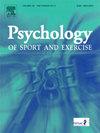业余和新手高尔夫推杆过程中注意力集中与大脑激活模式的关系:一项近红外光谱研究。
IF 3.1
2区 心理学
Q2 HOSPITALITY, LEISURE, SPORT & TOURISM
引用次数: 0
摘要
目的:外部注意力集中(FOA)已被证明可以改善运动表现。然而,最近的研究发现,FOA的有效性与专业知识水平有关。因此,本研究考察了FOA对不同专业水平高尔夫球手推杆成绩的影响。结合近红外光谱研究了FOA背后的神经机制。方法:共30名参与者,其中业余爱好者15名(年龄:23.31(SD = 1.32)岁;15名男性)和15名新手(法师:22.69(SD = 1.55)岁;11男性;4名女性)被招募。参与者戴着fNIRS完成EF和IF高尔夫推杆,每次持续3秒,每次30秒,间隔10秒休息。结果:行为学结果显示,EF条件下业余组推杆成绩与IF条件下有显著差异(P = 0.019), EF条件下业余组推杆成绩优于新手(P = 0.003)。fNIRS结果显示,中频条件下,业余组右侧体感关联皮层(RSAC)和右侧运动皮层(RMC)的激活水平较高。相比之下,新手组在EF条件下,左前额叶皮层和RMC的激活水平更高。结论:我们的研究结果表明,在IF条件下,业余组SAC和MC过度激活,推杆成绩较差。我们的研究结果表明,自动运动神经网络的损伤可能是IF影响SAC和MC过度激活的运动表现的可能机制。引导新手有意识地关注任务相关因素可能是EF提高运动表现的潜在机制。本文章由计算机程序翻译,如有差异,请以英文原文为准。
Association between the focus of attention and brain activation pattern during golf putting task in amateur and novice: A fNIRS study
Purpose
External focus of attention (FOA) has been shown to improve motor performance. However, recent research has found that the effectiveness of FOA is related to the level of expertise. Therefore, this study examined the effects of FOA on putting performance in golfers of different levels of expertise. The neural mechanisms behind FOA were explored in conjunction with fNIRS.
Method
A total of 30 participants, including 15 amateurs (Mage: 23.31(SD = 1.32)years; 15 males) and 15 novices (Mage: 22.69(SD = 1.55) years; 11 males; 4 females) were recruited. Participants completed EF and IF golf putting at a duration of 3s per time wearing fNIRS for 3 blocks of 30 s interspersed with 10-s rest blocks.
Result
Behavioral results showed a significant difference in the putting performance of the amateur group under the EF condition compared to the IF condition (P = 0.019), and relative to novices, the amateur group performed better under the EF condition (P = 0.003). fNIRS results revealed that the amateur group had higher activation levels in the right somatosensory association cortex (RSAC) and right motor cortex (RMC) under the IF condition. In contrast, for the novice group, higher activation levels were observed in the left prefrontal cortex and RMC under the EF condition.
Conclusions
Our results revealed SAC and MC over-activation in the amateur group under IF conditions with poor golf putting performance. Our findings suggest that the impairment of automated motor neural networks could be a possible mechanism by which IF affects motor performance with SAC and MC over-activation. Guiding novices to focus on task-related factors consciously could be a potential mechanism by which EF enhances motor performance.
求助全文
通过发布文献求助,成功后即可免费获取论文全文。
去求助
来源期刊
CiteScore
6.40
自引率
5.90%
发文量
172
审稿时长
69 days
期刊介绍:
Psychology of Sport and Exercise is an international forum for scholarly reports in the psychology of sport and exercise, broadly defined. The journal is open to the use of diverse methodological approaches. Manuscripts that will be considered for publication will present results from high quality empirical research, systematic reviews, meta-analyses, commentaries concerning already published PSE papers or topics of general interest for PSE readers, protocol papers for trials, and reports of professional practice (which will need to demonstrate academic rigour and go beyond mere description). The CONSORT guidelines consort-statement need to be followed for protocol papers for trials; authors should present a flow diagramme and attach with their cover letter the CONSORT checklist. For meta-analysis, the PRISMA prisma-statement guidelines should be followed; authors should present a flow diagramme and attach with their cover letter the PRISMA checklist. For systematic reviews it is recommended that the PRISMA guidelines are followed, although it is not compulsory. Authors interested in submitting replications of published studies need to contact the Editors-in-Chief before they start their replication. We are not interested in manuscripts that aim to test the psychometric properties of an existing scale from English to another language, unless new validation methods are used which address previously unanswered research questions.

 求助内容:
求助内容: 应助结果提醒方式:
应助结果提醒方式:


